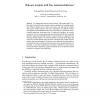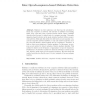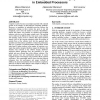58 search results - page 8 / 12 » Detection of New Malicious Code Using N-grams Signatures |
SP
2006
IEEE
15 years 5 months ago
2006
IEEE
Attackers and defenders of computer systems both strive to gain complete control over the system. To maximize their control, both attackers and defenders have migrated to low-leve...
122
click to vote
CAV
2011
Springer
14 years 2 months ago
2011
Springer
Abstract. The underground malware-based economy is flourishing and it is evident that the classical ad-hoc signature detection methods are becoming insufficient. Malware authors ...
ACSC
2006
IEEE
15 years 5 months ago
2006
IEEE
Code obfuscation is a relatively new technique of software protection and it works by deterring reverse engineering attempts by malicious users of software. The objective of obfus...
ESSOS
2010
Springer
15 years 7 months ago
2010
Springer
Malware is every malicious code that has the potential to harm any computer or network. The amount of malware is increasing faster every year and poses a serious security threat. H...
CASES
2005
ACM
15 years 28 days ago
2005
ACM
Computer security becomes increasingly important with continual growth of the number of interconnected computing platforms. Moreover, as capabilities of embedded processors increa...



